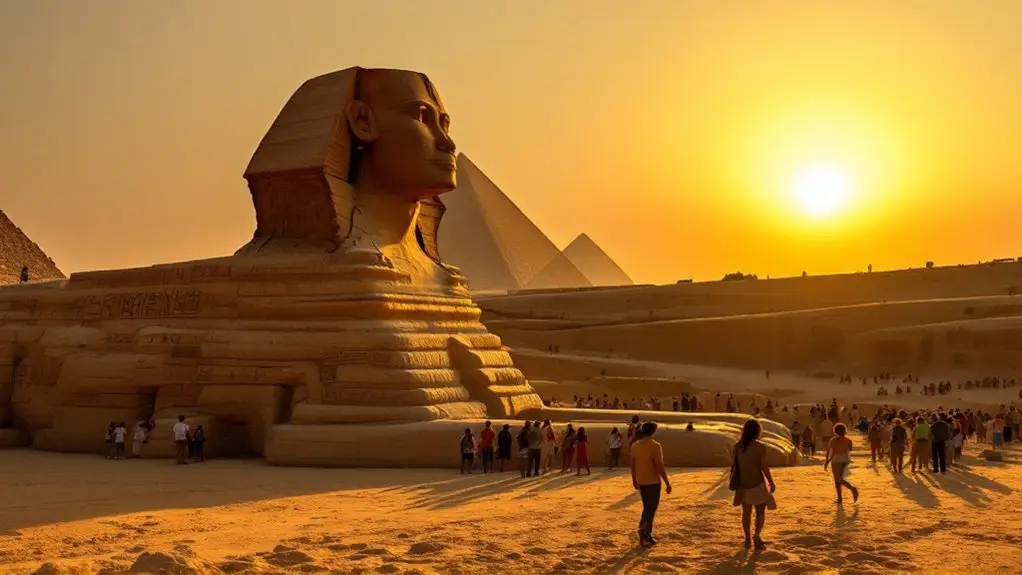Like the pages of an ancient manuscript waiting to be turned, Africa's cultural heritage sites offer a glimpse into the continent's rich tapestry of history and artistry. You might find yourself standing before the towering Great Pyramids of Giza or exploring the intricate engravings at Twyfelfontein, each location whispering stories of civilizations long past. These sites aren't just relics; they serve as crucial connections to both the past and the future. What other treasures might you uncover as you explore the profound narratives embedded within Africa's diverse landscapes?
Key Takeaways
- Africa boasts UNESCO World Heritage Sites like Stone Town and Robben Island, highlighting historical significance and cultural narratives.
- The Twyfelfontein Rock Engravings showcase ancient artistic expression through over 2,500 petroglyphs by the San people.
- Great Zimbabwe Ruins exemplify advanced engineering and architectural brilliance of early African civilizations.
- Timbuktu stands as a historical center of trade and scholarship, reflecting a rich intellectual and cultural heritage.
- The Cradle of Humankind offers educational insights into human evolution and the interconnectedness of humanity's past.
Stone Town, Zanzibar
Nestled on the enchanting Zanzibar Island, Stone Town is a fascinating UNESCO World Heritage Site that beckons visitors with its rich tapestry of history and culture.
As you wander through its narrow streets, you'll discover ornate wooden doors and intricate architectural details that reflect the diverse influences from Africa, Arabia, Persia, and India. This intriguing town, recognized for its well-preserved Swahili coastal trading town architecture, offers a unique glimpse into its vibrant past as a bustling trading port.
You can't miss the notable landmarks, such as the Sultans Palace and the Old Fort, each telling stories of a bygone era. The atmosphere is alive with the sounds and scents of the bustling markets, where spices and local crafts invite exploration.
Known as the Spice Island, Zanzibar's legacy of spice farming and processing adds another layer to the region's cultural heritage.
Walking through Stone Town, you'll appreciate how the urban fabric remains largely intact, allowing you to immerse yourself in its historical significance.
This UNESCO World Heritage Site isn't just a destination; it's a living representation of the rich cultural heritage that shapes Zanzibar today.
Great Zimbabwe Ruins
When you step into the Great Zimbabwe Ruins, you can't help but marvel at the stunning stone structures that whisper tales of a thriving ancient civilization.
These impressive remnants not only highlight the architectural brilliance of the time but also reveal the city's role as a bustling trade center, connecting diverse cultures across Africa.
As you explore, you'll uncover the legacy of urban planning and social organization that defined this iconic site.
Architectural Ingenuity Showcase
The Great Zimbabwe Ruins stand as a monumental tribute to the architectural ingenuity of early African civilizations. Constructed between the 11th and 15th centuries, this UNESCO World Heritage site showcases remarkable structures that reflect advanced engineering skills.
As you wander through the ruins, you'll encounter:
- The Great Enclosure – A massive stone wall encircling a vast area, demonstrating impressive craftsmanship.
- The Hill Complex – Elevated structures that offer panoramic views, hinting at the strategic planning of the site.
- Valley Ruins – Remnants of dwellings that reveal insights into daily life and social organization.
- Dry Stone Masonry – An incredible technique where stones fit together without mortar, showcasing a mastery of materials.
These features not only highlight the architectural ingenuity of Great Zimbabwe but also tell stories of a thriving trade hub that connected Southern Africa to distant markets in Arabia and Asia.
As you explore, you'll gain a deeper understanding of Africa's pre-colonial history, witnessing how these structures reflect the rich cultural and economic systems of the time.
Historical Trade Center Insights
Exploring the Great Zimbabwe Ruins reveals not just architectural marvels but also a thriving historical trade center that played a pivotal role in the region's economic landscape. Built between the 11th and 15th centuries, this UNESCO World Heritage Site served as the capital of the Kingdom of Zimbabwe, showcasing the sophisticated social and economic systems of early African civilizations.
As you wander through the impressive stone structures like the Great Enclosure and Hill Complex, you can almost hear the bustling exchanges that once took place here. Great Zimbabwe was a key trading hub, connecting the interior of Africa with coastal regions, particularly through Indian Ocean trade routes.
This site exemplifies the rich heritage and legacy of the Bantu-speaking peoples, who greatly contributed to the development of trade networks and cultural exchanges throughout Southern Africa.
Visiting Great Zimbabwe isn't just about witnessing the ruins; it's about understanding how this historical trade center influenced the region's economic dynamics and cultural interactions.
You'll leave with a deeper appreciation for the complexity and richness of Africa's pre-colonial history, all encapsulated within these ancient walls.
Livingstone Museum, Zambia
Nestled in the heart of Zambia, the Livingstone Museum stands as a tribute to the country's vibrant cultural heritage and the legacy of the renowned explorer David Livingstone. As the largest museum in Zambia, it offers a fascinating glimpse into the rich cultural tapestry of the nation and its indigenous traditions.
Here, you'll encounter:
- Ethnographic artifacts that tell stories of ancient tribes and their customs.
- Archaeological finds revealing the historical depth of Zambia's past.
- Exhibitions on traditional crafts, showcasing the skills that have been passed down through generations.
- Insights into Livingstone's explorations, connecting you to the adventures that shaped much of Africa's history.
The Livingstone Museum serves as a crucial educational resource, bringing to life the colonial history and natural wonders of the region.
It invites you to immerse yourself in Zambia's cultural narrative, making it a key attraction for anyone enthusiastic to understand the heritage sites in Africa.
Whether you're a history buff or a curious traveler, this museum promises an enriching experience that deepens your appreciation for Zambia's unique identity.
Twyfelfontein Rock Engravings
Just a few steps beyond Zambia's Livingstone Museum lies the remarkable Twyfelfontein Rock Engravings in Namibia, where history comes alive through the artistry of the San people.
This UNESCO World Heritage Site, designated in 2007 for its outstanding universal value, boasts over 2,500 petroglyphs etched into sandstone cliffs, making it one of Africa's largest concentrations of rock art.
As you explore the site, you're greeted by intricate carvings that depict scenes of hunting, daily life, and spiritual beliefs.
Each engraving offers a window into the culture and practices of ancient inhabitants, inviting you to ponder their connection to the land and each other.
The symbols and motifs resonate with the rich cultural heritage of the San people, providing invaluable insights into their world.
Twyfelfontein isn't just an archaeological site; it's a vibrant open-air gallery that highlights the artistic expression of early African civilizations.
Whether you're a history enthusiast or a casual visitor, you'll find that these ancient carvings tell stories that transcend time, deepening your understanding of human history in Southern Africa.
Robben Island, South Africa
Visiting Robben Island, you step into a powerful reminder of South Africa's turbulent past and the resilience of its people.
As you explore the stark prison buildings, the stories of former inmates like Nelson Mandela echo around you, offering a haunting glimpse into the struggle for freedom.
Guided tours enrich your experience, connecting you to the island's legacy and its role in the fight for equality.
Political Prison Legacy
Robben Island stands as a haunting symbol to South Africa's turbulent past, where the echoes of resistance resonate through its stark prison walls. Once a notorious political prison, it held many political prisoners, including Nelson Mandela for 27 years.
As you explore this UNESCO World Heritage Site, you'll witness the profound sacrifices made in the struggle for freedom.
Imagine:
- The oppressive concrete of Mandela's cell, a mere 7 feet by 9 feet, where hope flickered in the darkest hours.
- The rusted bars that confined brave souls, yet couldn't imprison their indomitable spirit.
- The desolate landscape surrounding the prison, a reminder of isolation, yet also a canvas for resilience.
- The whispers of past struggles carried by the wind, telling stories of courage and unwavering determination.
Robben Island remains a powerful symbol of the fight against apartheid, embodying both resilience and hope.
It underscores the importance of reconciliation and the ongoing journey toward democracy in South Africa.
Visiting this site, you'll not only reflect on its historical significance but also connect with the universal longing for justice and equality.
Guided Historical Tours
Beginning a guided historical tour of Robben Island immerses you in the profound narrative of South Africa's struggle for freedom and justice. As you step onto this UNESCO World Heritage Site, you'll explore the prison where Nelson Mandela spent 18 years, gaining insights into the harsh realities faced by political prisoners.
The tours are led by former inmates who share personal experiences, making the history tangible and relatable. You'll visit Mandela's cell and other significant sites, each telling a story of resilience amidst adversity. While the island's stark landscapes reflect its somber past, they also showcase a natural beauty that contrasts with its history.
Here's a snapshot of what to expect on your tour:
| Tour Highlights | Insights from Guides | Visitor Experience |
|---|---|---|
| Mandela's Cell | Personal stories of survival | Reflective moments |
| Historical Exhibits | Contextual background | Engaging discussions |
| Nature Walks | Connection to heritage | Scenic views |
| Memorials | Lessons on justice | Deepened understanding |
As you leave Robben Island, you carry a powerful reminder of the fight for justice and equality.
Aksum, Ethiopia
Nestled in the heart of northern Ethiopia, Aksum stands as proof of the grandeur of the Aksumite Empire, which flourished over a millennium ago. This ancient city, recognized as a UNESCO World Heritage Site since 1980, invites you to explore its rich history and cultural significance.
Here are some highlights you won't want to miss:
- Monumental Obelisks: Marvel at the towering stelae, believed to mark the graves of powerful kings, showcasing advanced engineering from the 4th century AD.
- Church of St. Mary of Zion: Visit this sacred site, thought to house the Ark of the Covenant, pivotal in early Ethiopian Christianity.
- Ancient Palaces: Wander through the ruins, imagining the lives of emperors who once held court in this vibrant trading center.
- Tombs: Discover the intricate burial sites that reveal the spiritual beliefs and customs of the Aksumite civilization.
As you walk through Aksum, you'll feel the echoes of a once-thriving empire, making it an enchanting destination for anyone keen to understand Africa's profound cultural heritage.
Great Pyramids of Giza
When you stand before the Great Pyramids of Giza, you can't help but marvel at their ancient engineering brilliance.
These monumental tombs not only reflect the incredible skills of their builders but also tell profound stories about the Pharaohs and their beliefs in the afterlife.
As one of the Seven Wonders of the Ancient World, they embody a rich historical significance that continues to captivate explorers and scholars alike.
Ancient Engineering Marvels
The Great Pyramids of Giza stand as towering monuments to the ingenuity of ancient Egyptian civilization. Constructed around 2580–2560 BCE, these monumental tombs, especially the Great Pyramid of Khufu, showcase remarkable engineering that continues to fascinate.
Imagine the sheer effort involved in creating these structures:
- Height of 481 feet – Dominating the skyline, it was the tallest man-made structure for over 3,800 years.
- 2.3 million blocks – Crafted from limestone and granite, these blocks reveal the ancient Egyptians' mastery of materials.
- Astronomical alignment – Each pyramid aligns perfectly with celestial bodies, showcasing advanced mathematical knowledge.
- Intricate hieroglyphs – Inside, detailed carvings narrate beliefs about death and the afterlife, offering a glimpse into a complex worldview.
Recognized as a UNESCO World Heritage Site in 1979, the Giza pyramid complex, including the Sphinx, stands not only as a symbol of architectural prowess but also as a cultural touchstone.
Visiting these ancient engineering marvels allows you to appreciate the incredible legacy of the ancient Egyptians, their ingenuity, and their enduring influence on our world today.
Historical Significance Explained
Standing as a demonstration to ancient Egyptian civilization's grandeur, the Great Pyramids of Giza offer more than just spectacular views; they hold profound historical significance that shapes our understanding of the past. Constructed around 2580–2560 BC, these monumental tombs were designed for pharaohs, with Khufu's pyramid towering at an impressive 481 feet. Recognized as a UNESCO World Heritage Site in 1979, they exemplify the architectural ingenuity and precision of ancient engineering.
The pyramids' construction showcases an advanced understanding of labor organization, utilizing massive limestone blocks. Hieroglyphs within their chambers narrate significant historical tales, revealing insights into the religious beliefs and practices of ancient Egyptians. Remarkably, they are the only surviving structures of the Seven Wonders of the Ancient World, underscoring their enduring historical significance.
| Feature | Details | Significance |
|---|---|---|
| Construction Period | 2580–2560 BC | Reflects advanced engineering techniques |
| Height | Khufu's pyramid: 481 feet | Symbol of pharaonic power and legacy |
| UNESCO Status | Recognized in 1979 | Preserves global cultural heritage |
| Hieroglyphs | Insights into ancient religion | Offers historical narratives |
Timbuktu, Mali
Timbuktu, often called the "City of Gold," beckons with its rich tapestry of history and culture. Nestled near the Sahara Desert, this UNESCO World Heritage Site flourished as a center of trade and scholarship during the Mali Empire, particularly between the 14th and 16th centuries.
As you explore its winding streets, you'll encounter:
- The majestic Djinguereber Mosque, a stunning example of mud-brick architecture.
- The illustrious Sankore Madrasah, where scholars once gathered to exchange knowledge.
- Ancient manuscripts, whispering tales of a time when ideas flowed like the Niger River.
- Vibrant markets, where spices and textiles reflect the diverse cultures that converged here.
Despite facing challenges like desertification and political instability, Timbuktu remains a symbol of Africa's rich cultural heritage.
Its architecture and history reflect the convergence of diverse African civilizations, making it a crucial part of our global story.
Visiting Timbuktu isn't just about witnessing its beauty; it's about connecting with a legacy that continues to inspire and educate.
Embrace the spirit of this remarkable city, and you'll find a treasure trove of insights waiting to be uncovered.
Ancient City of Carthage
Nestled along the coast of present-day Tunisia, the Ancient City of Carthage captivates with its storied past and architectural wonders. As you explore this UNESCO World Heritage Site, you'll encounter significant archaeological remains that tell the tale of a once-mighty Phoenician city.
| Key Features | Description |
|---|---|
| Antonine Baths | Impressive ruins showcasing Roman engineering |
| Roman Theater | A venue that once hosted grand performances |
| Tophet | A sacred site associated with ancient rituals |
Carthage thrived as a major trading hub from the 9th century BC, marking its importance in the Mediterranean. You'll feel the echoes of history, especially during the Punic Wars, when the legendary Hannibal Barca led daring campaigns against Rome. Although the city faced destruction in 146 BC, it was rebuilt and later flourished as a Roman city.
Today, walking through the ruins, you gain insights into ancient Mediterranean civilizations. Each stone, each structure, whispers stories of resilience and cultural richness, making your visit not just a journey through ruins, but a profound exploration of human history.
Cradle of Humankind
The Cradle of Humankind, a remarkable UNESCO World Heritage Site, beckons with its rich tapestry of human history and evolution. Just 50 kilometers from Johannesburg, this gem is a must-visit for anyone curious about our origins.
As you explore, you'll encounter:
- The Sterkfontein Caves, where early hominin fossils dating back 3.5 million years were discovered.
- The Maropeng Visitor Centre, featuring interactive exhibits that narrate the story of human ancestry.
- A breathtaking array of biodiversity, showcasing endemic flora and fauna native to the region.
- A deep sense of wonder as you stand in the very landscapes that shaped humanity.
This site isn't just important for its archaeological significance; it's crucial for understanding the evolution of our species.
With one of the richest concentrations of hominin fossils in the world, the Cradle of Humankind offers insights that resonate with researchers and visitors alike.
Whether you're delving into the past or appreciating the present, this UNESCO World Heritage Site invites you to connect with the roots of humanity in a way that's both educational and inspiring.
Frequently Asked Questions
Which African Nation Has the Richest Cultural Heritage?
When you think about which African nation has the richest cultural heritage, Ethiopia often stands out.
Its cultural diversity features ancient traditions, vibrant festivals, and unique languages that reflect a deep historical significance.
You'll find traditional practices rooted in centuries of history, evident in its churches and monuments like Aksum's obelisks.
Which African Country Has the Most World Heritage Sites?
When it comes to World Heritage Sites in Africa, South Africa and Morocco tie with 10 each, showcasing their remarkable cultural and natural significance.
You'll discover South Africa's sites like Robben Island and the Cape Floral Region, while Egypt's monuments, including the Pyramids of Giza, speak to ancient civilizations.
Tanzania's landscapes, such as Serengeti National Park, highlight the continent's breathtaking biodiversity.
Each country offers a unique glimpse into Africa's rich history and heritage.
What Is the Most Cultural Place in Africa?
You might think it's hard to pinpoint the most cultural place in Africa, but you'll find vibrant traditions everywhere.
Cities like Addis Ababa in Ethiopia shine with traditional festivals, showcasing colorful ceremonies and music that echo the nation's history.
The preservation of indigenous languages adds depth to the experience, offering insights into diverse cultures.
Exploring these elements, you'll discover a rich tapestry that defines Africa's unique cultural identity, enchanting visitors at every turn.
What Is the Rich Cultural Heritage of Nigeria?
Nigeria's rich cultural heritage captivates you with its vibrant festivals, colorful traditional attire, and diverse indigenous languages.
You'll find lively celebrations like the Osun-Osogbo Festival, where spiritual rituals come alive. The intricate designs of traditional garments reflect deep-rooted customs and artistry.
With over 250 languages spoken, each community shares unique stories and traditions, enriching the cultural tapestry.
Immerse yourself in this dynamic heritage, where history and modernity blend seamlessly, inviting exploration and appreciation.
Conclusion
As you wander through Africa's cultural heritage sites, you'll find threads of history weaving together stories of resilience and creativity. Each monument, from the majestic Great Pyramids to the ancient ruins of Great Zimbabwe, whispers tales of civilizations that shaped our world. These treasures not only honor the past but also ignite a spark of curiosity within you, urging you to explore, learn, and carry forward the rich tapestry of Africa's vibrant history for generations to come.








